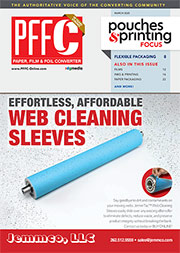Featured Stories
-
Collaboration with OEMs Advances Mono-material Packaging Solutions
Flexible packaging is incredibly versatile, providing manufacturers with a wide variety of sizes and dimensions, structures and features to... -
Enhancing Sustainability in Flexible Packaging through Latex Binders
Evolving government regulations and consumer demands continue to drive interest in sustainable packaging materials. -
It's All About Adhesion A Simple Guide to Corona Treatment
Corona treatment has come a long way since Verner Eisby, the founder of Vetaphone, invented it in 1950.
News | New Products
-
ELBA’s SA-V machine: efficiency and innovation at the service of your business
Technologically advanced and engineered to run at high speeds, the SA-V automatic machine...
-
GFI Ink Dispensing System drives precision for impressive results at Colbert Packaging Corporation
Colbert Packaging Corporation has a long history of satisfying customers.
-
Join Megadyne at ICE Europe 2025: What’s Next for Paper and Print Manufacturing?
In the fast-paced world of paper and print manufacturing, every component of the production line is crucial to keeping operations running smoothly.
-
2025 Trends Shaping the Label Industry
Brand owners rely on converters to help them bring their packaging visions to life and to help meet their business goals.
-
IPCO at European Coatings 2025
Industrial process systems company IPCO will use European Coatings Show – Hall4, Stand 618
-
Expanded Valmet Technology User Group Conference offers insights on optimizing production efficiency and product quality
Valmet recently hosted the Valmet Technology User Group (VTUG) Conference.
-
FPA Announces the 2025 Flexible Packaging Achievement Award Winners
The Flexible Packaging Association (FPA), the leading advocate and voice for the growing U.S. flexible packaging industry
Expert Advice
Barrier Properties of EVOH at Low Temperatures and Various Humidity
- Published: April 01, 2001, By Tomoyuki Yamamoto & Yuko Nishihara, Nippon Gohsei
Email the author(s) at: This email address is being protected from spambots. You need JavaScript enabled to view it.
Application: Estimation of oxygen transmission rate at any temperature and humidity is possible using humidity, temperature, and ethylene content.
Ethylene vinyl alcohol copolymer (EVOH) is an excellent barrier resin for use in food and nonfood packaging applications. Since the material is hygroscopic, gas barrier properties depend on humidity. The barrier properties of EVOH at low temperature are important since EVOH packaging films have frequent use at the low temperatures found in refrigerated storage conditions. This paper reveals the cause of the reduction of gas barrier under high humidity using a rheological method. It also describes the relationship of oxygen transmission rate (OTR), moisture content, humidity, and temperature.
Experimental
Film samples were made from commercial grades of EVOH with 32, 38, and 44 mol% ethylene content at 15-30 microns. Extruded films were immediately placed in aluminum bags to avoid absorption of moisture until measured for water absorption and OTR.
OTR measurement used a commercially available instrument with temperature of 5°C-20°C and 0%-100% RH. Investigation of the effect of humidity on mechanical properties of EVOH used a commercially available viscoelastic rheometer. The dynamic viscoelastic behavior was measured at 15%-90% RH as a function of temperatures at 10°C-60°C. Measurement frequency was 10 Hz, and scan speed was 0.5% RH/min. Water absorption measurement used storage in either a temperature and humidity chamber or desiccators containing saturated salt solutions.
OTR Results
Figure 1 shows the relative humidity dependence of OTR at various temperatures for the 44% grade of EVOH. This is a popular grade for packaging materials intended for fresh meat, processed meats, etc. The OTR of EVOH increases under high humidity even at low temperature. The OTR at low temperature and high humidity is near that at room temperature under low humidity.
Arrhenius plots of the OTR in 0% RH showed straight line relationships for all specimens. Arrhenius plots of the OTR at the various percentage moisture content for each EVOH grade indicated that the OTR nearly increased in parallel when the percentage of moisture content increased. A figure showing relationship between the percentage water absorption and OTR at various temperatures provides an estimate for the OTR from the percentage of moisture content and temperatures.
Water Absorption
The work indicated that moisture content under constant temperature might dominate the OTR of EVOH. A calculation of the moisture content in EVOH from the relative humidity would therefore allow calculation of the OTR at any temperature and humidity. Work showed that moisture content does increase with increasing humidity, but the moisture content does not seem to depend on temperature.
When the temperature is different, the water vapor pressure is also different even at the same humidity. Calculations by the authors showed the dependence of the solubility coefficient on absolute temperature. The solubility coefficient is also related by exponential functions of the inverse absolute temperature. Ethylene content depends on the solubility coefficient. Using this information, the authors derived a modified Arrhenius equation. Figure 2 shows good agreement for this equation with experimental results. This therefore allows estimation of the moisture content at any temperature and humidity by the modified Arrhenius equation. Estimation of the OTR needs only the three factors of humidity, temperature, and ethylene content.
Conclusions
The authors found that the OTR of EVOH at low temperature of 5°C-10°C and high humidity of 100% RH was close to that at room temperature under low humidity. This is because the Tg of EVOH falls to 5°C-10°C. The humidity where the OTR begins to increase is closely related to the humidity dependence of Tg. The work also clarified the relationship of OTR, moisture content, relative humidity, temperature, and ethylene content. Using this relationship allows estimation of OTR using only humidity, temperature, and ethylene content.













